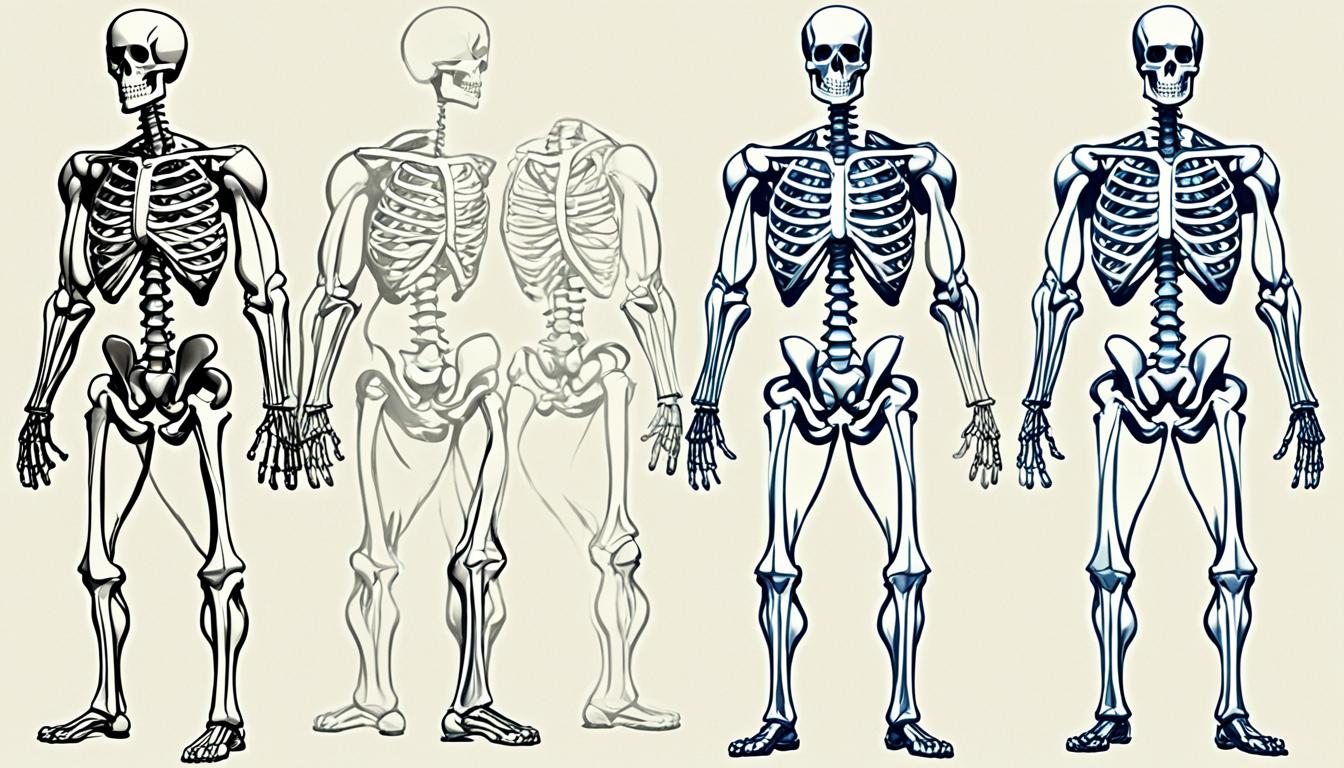How to Draw Bodies – Drawing Turorials and Coloring Tips
Learning how to draw bodies can be a challenging endeavor. However, with the right techniques and guidance, anyone can improve their figure drawing skills and create realistic and lifelike artwork. In this article, we will provide step-by-step tutorials on drawing bodies, along with valuable tips on anatomy, shading, and color theory. Whether you’re a beginner or an experienced artist looking to enhance your skills, you’ll discover helpful insights to take your body drawing abilities to the next level.
Key Takeaways:
- Learn how to draw bodies effectively with step-by-step tutorials.
- Understand the importance of anatomy and proportions in achieving realistic figure drawings.
- Discover essential tips for adding details, refining your drawings, and enhancing their three-dimensionality.
- Experiment with different poses, angles, and gestures to improve your understanding of the human form.
- Explore figure drawing courses and resources to further develop your skills and knowledge.
Method 1: Sketching the Wire Frame
In this section, we will discuss the first method of drawing bodies: sketching the wire frame. This technique involves using basic shapes and lines to create the foundation of the human body. By utilizing this approach, you can establish a solid structure and proportion before adding intricate details.
To begin, start by drawing circles and lines to outline the overall shape of the body. These circles will act as the head, torso, and limbs, while the lines will represent the basic skeletal structure. By focusing on these fundamental shapes, you can ensure accuracy and maintain proper proportions throughout your drawing.
Once you have the basic framework, you can gradually add additional shapes as a guide to create the human figure. Use these shapes to outline the major body parts, such as the chest, hips, arms, and legs. By referring to the human anatomy, you can ensure that your sketch accurately captures the proportions and movements of the body.
After sketching the outline, take the time to erase any excess lines and refine the wire frame. This step will help you achieve a clean and clear foundation for your drawing. Use an eraser to remove any unnecessary lines while leaving the essential shapes intact.
With the wire frame complete, it’s time to bring your drawing to life. Start by adding skin color using shading techniques that emphasize the contours of the body. Play with light and shadow to create depth and dimension. This will give your drawing a more realistic appearance, as if the human body is occupying physical space.
Remember, sketching the wire frame is just the first step in drawing bodies. By starting with basic shapes and lines, you establish a strong foundation that sets the stage for more detailed work. With practice and experimentation, you can refine your skills and create captivating drawings that showcase the beauty and complexity of the human form.
Method 2: Using Geometric Shapes
In this section, we will explore an alternative approach to drawing bodies by utilizing geometric shapes. By incorporating these shapes, you can effectively define body parts and maintain accurate proportions in your artwork.
Begin by sketching the wire frame of the body using basic shapes such as circles and ovals. This initial step helps provide a solid foundation for your drawing. Pay close attention to the proportions to ensure realistic representation. For instance, the head should be approximately one-eighth of the body height, while the legs should occupy around three-eighths of the total height.
Once you have established the basic shapes, it’s time to add more details to the body parts. Trace over the sketch with precise lines, refining the outline and erasing any unnecessary scaffolding. Remember to focus on essential anatomical features to achieve a well-defined figure.
To bring your drawing to life, incorporate skin color and shading. These elements add depth and dimension, enhancing the overall realism of your artwork. Experiment with shading techniques to create highlights, shadows, and subtle variations in tone, giving your figures a three-dimensional appearance.
Using geometric shapes can be particularly useful when drawing both male and female figures. By following this method, you can ensure that the proportions of each body type remain accurate and proportional. This approach helps you develop a solid foundation for capturing the distinctive characteristics of the male and female form.
Remember, practice is key to mastering body drawing techniques. Continuously experiment with different shapes, proportions, and shading styles to refine your skills. The more you practice, the more confident and proficient you will become in creating lifelike figures.

Illustration: By incorporating geometric shapes, you can define body parts and maintain accurate proportions in figure drawing.
Anatomy and Proportions
Understanding human anatomy and body proportions is crucial for creating realistic figure drawings. The human body follows specific ratios and measurements that vary between individuals and genders. By studying and practicing these principles, you can bring accuracy and lifelike qualities to your art.
Human Anatomy
Human anatomy is the foundation of figure drawing. It involves understanding the structure and proportions of different body parts. Here are some key aspects to consider:
“Anatomy is to the artist what the alphabet is to the writer.”
– Frank J. Reilly
- The head forms one-eighth of the body height.
- The torso, including the chest and abdomen, occupies approximately three-eighths of the body height.
- The upper and lower limbs, such as the arms and legs, make up the remaining body height.
The knowledge of human anatomy enables you to accurately position and proportion body parts, resulting in a more cohesive and believable figure.
Male and Female Body Proportions
Male and female bodies have distinct characteristics and proportions. Understanding these differences adds authenticity and detail to your drawings:
| Male Body | Female Body | |
|---|---|---|
| Shoulders | Broader | Narrower |
| Waist | Narrower, less curvy | Curvier, more defined |
| Hips | Narrower | Wider |
These variations in body proportions contribute to the overall shape and silhouette of the male and female figures.
Now that you have a foundation in anatomy and proportions, you can apply this knowledge to create more accurate and believable figure drawings.

Next Steps
Now that you understand the importance of anatomy and proportions, it’s time to put your knowledge into practice. In the next section, we will delve into adding details and refining your drawings, bringing your figures to life with depth and realism.
Adding Details and Refining the Drawing
Once the basic shape and proportions of your drawing are established, it’s time to add the finer details and refine your artwork. This step is crucial for bringing your drawing to life and making it more realistic and three-dimensional.
Start by erasing any sketch lines that are no longer needed. This will help create a cleaner and more polished appearance for your drawing. Use a kneaded eraser or a fine point eraser to gently remove the excess pencil lines without smudging the surrounding areas.
Next, it’s time to focus on adding depth and enhancing the details of the body parts. Switch to a darker pencil or a fine-lead mechanical pencil to define the outlines and contours of the various body elements. Pay attention to the curves, angles, and subtle nuances of the anatomy to capture the true essence of the figure.
Remember that shading plays a crucial role in adding depth and dimension to your drawing. Analyze the light source in your reference or imagination and determine how it affects the body’s different surfaces. Use shading techniques such as hatching, cross-hatching, and blending to create realistic shadows and highlights.
When shading, consider the direction of the light source and adjust the darkness of your shading accordingly. Areas that are directly hit by the light should be lightly shaded, while areas facing away from the light should be darker. This technique helps to create a sense of volume and make the body parts appear more three-dimensional.
Additionally, pay attention to the smaller details that contribute to the overall realism of your drawing. Add creases, wrinkles, muscle definition, and other subtle variations in the body to capture its unique characteristics. Remember to refer back to your anatomical studies and observation of real-life references when adding these details.
To further refine your drawing, continuously step back and assess your work from a distance. Look for any areas that need adjustment or further detailing. Sometimes, taking a break and coming back with fresh eyes can help you spot areas for improvement.
By adding intricate details and refining your drawing, you can elevate the overall quality and visual impact of your artwork. With practice and patience, you’ll develop a keen eye for capturing the essence of the human form and create stunning body drawings that showcase your artistic skill and creativity.
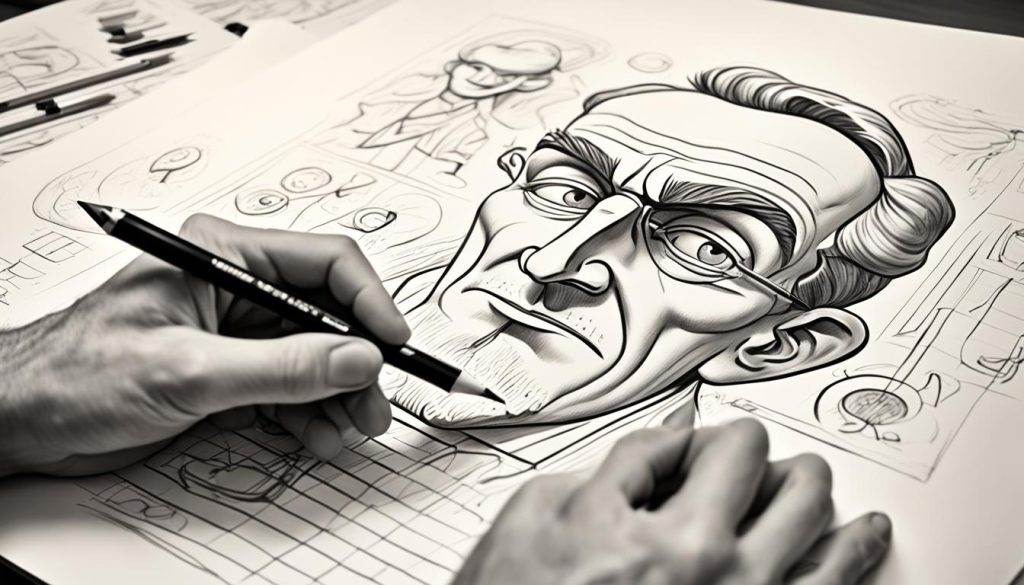
Practicing and Experimenting with Different Poses
To become proficient in drawing bodies, practice is key. By dedicating time and effort to practicing, you can hone your skills and improve your understanding of the human form. Additionally, experimenting with different poses and angles can provide you with valuable insights and enhance your ability to capture movement and body dynamics in your drawings.
One effective way to improve your understanding of body proportions and movements is by using reference images. Whether online or from live models, referencing images allows you to study the intricacies of the human body and observe how it reacts in various poses and actions.
Gestures drawing is a beneficial exercise that involves capturing the flow and posture of the body through quick, simplified sketches. This exercise helps to train your observation skills and develop a sense of movement in your drawings. It allows you to focus on capturing the essence of a pose rather than getting caught up in details.
Benefits of Practicing and Experimenting with Different Poses
- Enhances your understanding of body proportions and movements
- Improves your ability to capture dynamic poses and actions
- Develops your observation skills
- Allows you to explore different artistic styles and approaches
- Boosts your creativity and artistic expression
Remember, the more you practice and explore different poses, the more comfortable and confident you will become in your ability to draw bodies. It’s all about experimentation, pushing your boundaries, and continuously learning and growing as an artist.
“Art is not about the end result; it’s about the journey of self-discovery and expression.”
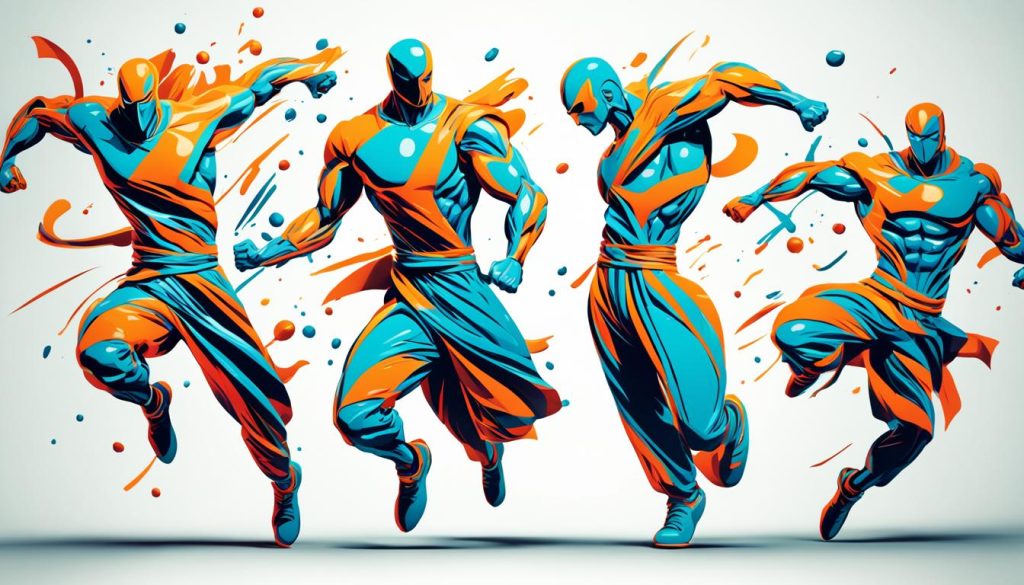
| Posing Tip | Description |
|---|---|
| Dynamic Action | Experiment with poses that depict dynamic movements like running, jumping, or dancing. |
| Contrapposto | Explore the classic contrapposto pose to understand weight distribution and balance. |
| Symmetry vs. Asymmetry | Compare and contrast poses with symmetrical and asymmetrical body positions. |
| Foreshortening | Challenge yourself with poses that involve foreshortening, where body parts appear shorter due to perspective. |
Using Figure Drawing Courses and Resources
If you’re serious about improving your figure drawing skills, consider enrolling in figure drawing courses or utilizing online resources. These courses provide structured learning and guidance from experienced artists. They cover topics such as anatomy, proportions, gesture drawing, and advanced techniques.
Figure drawing courses offer a comprehensive approach to learning, allowing you to develop a solid foundation in figure drawing. With expert instruction and feedback, you can enhance your understanding of human anatomy, learn how to capture the essence of different body types, and refine your skills in shading and rendering.
Online resources are also invaluable tools for expanding your knowledge and improving your techniques. There are numerous books, tutorials, and videos available that offer step-by-step guidance, tips, and insights from professional artists. Whether you prefer written materials or visual demonstrations, you’ll find a wealth of resources to enhance your figure drawing abilities.
Benefits of Figure Drawing Courses and Resources
“Figure drawing courses provide structured learning and guidance from experienced artists, while online resources offer a wide range of tutorials and references to improve your skills.” – Sarah Johnson, Professional Artist
- Structured Learning: Figure drawing courses offer a systematic approach to learning, guiding you through different aspects of figure drawing in a logical progression. This ensures that you acquire a solid foundation and build upon it step by step.
- Expert Guidance: Enrolling in a figure drawing course allows you to benefit from the expertise of experienced artists. They can provide personalized feedback and valuable insights to help you overcome challenges and improve your drawing skills.
- Anatomy and Proportions: Figure drawing courses and resources often dedicate significant attention to human anatomy and proportions. By studying and understanding the structure of the human body, you’ll be better equipped to accurately depict figures in your drawings.
- Gesture Drawing: Many figure drawing courses emphasize the importance of gesture drawing, which involves capturing the essence and movement of a pose in quick, fluid sketches. This technique helps train your eye to observe and depict the dynamic nature of the human form.
- Advanced Techniques: Figure drawing courses often delve into advanced techniques such as shading, rendering, and creating lifelike textures. These skills can elevate the quality and realism of your figure drawings, allowing you to capture the subtle nuances of the human body.
By combining figure drawing courses with online resources, you can create a comprehensive and well-rounded approach to improving your figure drawing skills. Take advantage of the structured learning and expert guidance provided by courses, while simultaneously exploring the vast array of tutorials, books, and videos available online. This combination of resources will enhance your learning experience and accelerate your artistic growth.
Whether you’re a beginner or an experienced artist looking to refine your skills, figure drawing courses and resources are invaluable tools for enhancing your understanding of the human form and improving your figure drawing abilities.
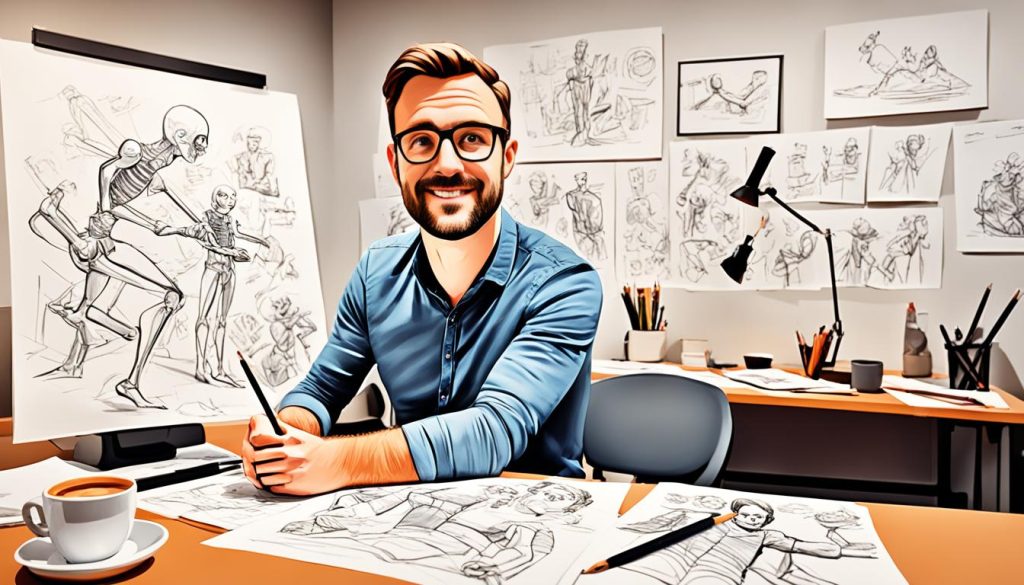
The Importance of Observation and Study
Observation and study are fundamental aspects of mastering the art of drawing bodies. By keenly observing the people and objects around you, you can gain valuable insight into their proportions, movements, and body language. This acute observation will greatly enhance your ability to accurately depict the human form.
One effective method of study is to immerse yourself in various visual references. Dive into a treasure trove of photographs, artwork, and anatomy books that provide a deeper understanding of the human body. By studying these references, you can absorb the intricacies of muscle structure, skeletal composition, and facial expressions, enabling you to capture lifelike figures in your drawings.
“The best way to understand the world of art is to dive deeply into the subject, to immerse yourself in it with all your senses, heart and mind. You need to study, analyze, feel and be open to all its complexities and nuances.”
– Leonardo da Vinci
Developing your visual memory is another vital component of observational learning. After observing a subject, challenge yourself to sketch from memory, striving to capture all the minute details you have absorbed. This practice will bolster your ability to retain visual information and apply it with accuracy and precision.
The Power of Visual Learning
Visual learning has been proven to be highly effective in acquiring and retaining knowledge. As you continuously observe and study the human form, your brain forms a visual library of proportions, gestures, and anatomical details. This visual memory serves as a wellspring of inspiration and reference when you embark on your own artistic endeavors.
Remember, the more you invest in observation and study, the more instinctive and effortless your figure drawing will become. By internalizing the principles and intricacies of the human body, you will possess the tools necessary to breathe life into your artwork.
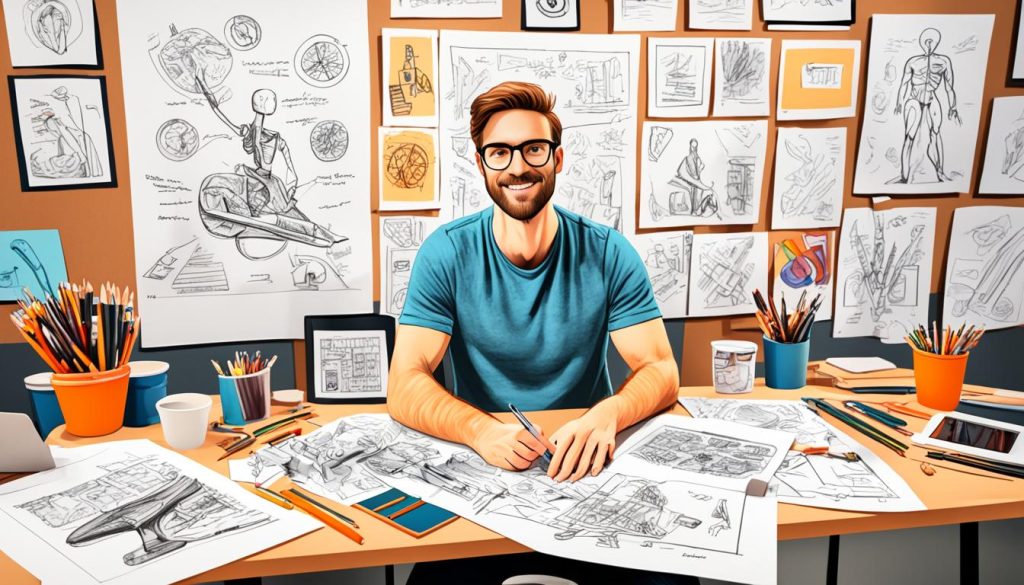
| Reference | Description |
|---|---|
| Academy of Art University Online Figure Drawing Course | A comprehensive online course that covers anatomy, proportions, and figure drawing techniques. |
| Andrew Loomis’ “Figure Drawing for All It’s Worth” | A classic instructional book that provides in-depth guidance on figure drawing fundamentals. |
| Proko’s Figure Drawing Videos | A series of highly educational and entertaining videos, offering detailed tutorials on anatomy and figure drawing. |
| The Metropolitan Museum of Art’s Online Collection | An extensive digital collection of artworks featuring diverse styles and representations of the human form. |
Tips for Improving Body Drawing Skills
Improving your body drawing skills requires practice, experimentation, and creativity. Here are some valuable tips to enhance your abilities:
- Practice regularly: Consistent practice helps develop muscle memory and improves your overall drawing technique. Set aside dedicated time each day to sketch and refine your body drawings.
- Experiment with different mediums and techniques: Try using various art mediums, such as charcoal, colored pencils, or digital tools, to explore different textures and effects. Experimenting with different techniques, like cross-hatching or stippling, can add depth and dimension to your drawings.
- Seek feedback from other artists or join a community of artists: Sharing your work with other artists can provide valuable insights and constructive criticism. Joining an art community or participating in art forums allows you to connect with like-minded individuals, gain inspiration, and learn from their experiences.
- Break down complex poses into simpler shapes and lines: When faced with complex poses, break them down into basic geometric shapes and lines. This approach helps establish the underlying structure and proportions of the body, making it easier to accurately capture the pose.
- Embrace creativity: While learning the fundamentals is important, don’t be afraid to inject your own artistic style and creativity into your drawings. Experiment with different poses, angles, and interpretations to create unique and expressive body drawings that showcase your individuality.
Remember, improving your body drawing skills is a continuous journey. Keep practicing, exploring new techniques, and pushing your creative boundaries to continually grow and refine your abilities.
Conclusion
Learning how to draw bodies is a journey that requires dedication, practice, and a touch of creativity. By following step-by-step tutorials, understanding the intricacies of anatomy and proportions, and consistently honing your skills, you can witness remarkable growth in your figure drawing abilities. Don’t be afraid to push your boundaries and experiment with different poses, and remember to seek guidance from figure drawing courses and resources to enhance your learning experience.
Through practice, you will develop a keen eye for details and a better understanding of the human form. Embrace the process of continuous improvement and never stop expanding your artistic horizons. With each stroke of the pencil, each shade added, and each line refined, you will witness your body drawings come to life with a newfound sense of depth and realism.
Ultimately, the path to becoming an accomplished body artist lies in your hands. Embrace the journey, embrace the joy of creation, and keep practicing. As you persist in refining your techniques and developing your own unique style, you will unlock new levels of artistic growth and create impressive body drawings that captivate and inspire.
